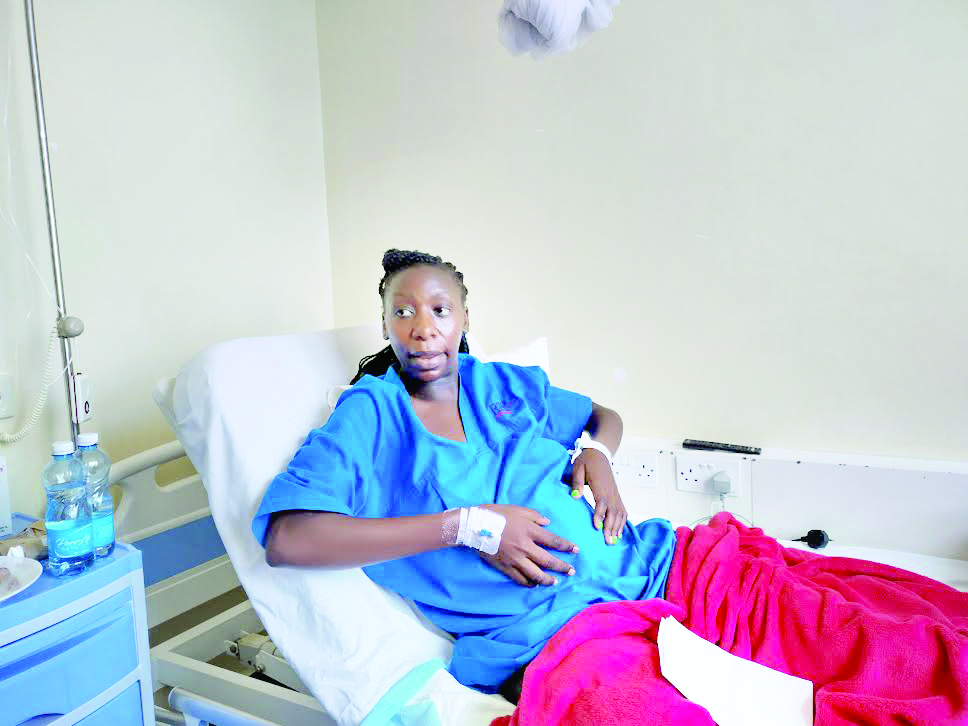I lost my baby and womb in the delivery room

Although she did not have a strict birth plan in place even as her Estimated Date of Delivery (EDD) approached, Margret Mukoya had conjured images of her baby’s first cry and how the doctors would announce the landing of her pink jet.
It was February 14 this year and her EDD had lapsed by five days, however, while she was troubled by this, the devastating death of a close aunt worsened her nerves and all she hoped for was to deliver the baby and mourn aunt at ease.
With everything going on, 31-year-old Margret decided to contact her gynecologist to ask whether there was a possibility for a labour induction, and the gynecologist referred her to Ruai Family Hospital (RFH) Specialist Hospital branch, which she explains was one of the hospitals where she said she had a great team on standby who could attend to her promptly.
“At 36 weeks, my baby was in breech position, but that didn’t worry me because my gynecologist had told me that in some cases the foetus turns to present itself in a posterior position, and true to her words, by the time we were getting to 40 weeks, the baby had already turned and her head engaged the cervix ready for delivery,” she explains, adding that medical examinations showerd that the baby was of good health and weighed 4.1 kilogrammes. She was booked for admission at 11am the following morning.
Second labour Induction
The first dose of medication was administered at 12.30pm and she thought the pain would progress really fast, but that wasn’t the case. “I didn’t feel any pain, in fact, I remember calling my doctor and asking so many questions and she explained that I still had two more doses left and that my second dose would be at 8pm, which would intensify the contractions,” she says.
However, she was surprised when the nurse came one and a half hours earlier at 6.30pm to give her the second dose, contrary to what the doctor had said earlier.
“I kept asking myself what had changed, but I didn’t want to think too much about it, especially since I was dealing with medics who knew what they were doing,” she explains.
Shortly after the injection, she felt an increased urge to poop and she rushed to the toilet.
By that time, she was having some mild contractions on her back and belly at intervals of about 10 to 15 minutes. “After a few minutes, I got another urge to poop, I called the nurses and she suggested I follow her to the delivery room for an examination,” she recalls.
On her way, she felt some intense contractions, which left her so weak that she couldn’t walk. She recalls trying to call out for help as she was unable to catch up with the nurse who hurriedly walked ahead of her.
Luckily, her husband, who was walking behind her managed to carry her to the delivery room. “The nurse did a vaginal examination, which showed that I was 10 centimetres dilated and I was happy at the thought that I would be walking out of the room with my bundle of joy in a few minutes,” Margret recounts as she bursts out in tears.
But as fate could have it, the delivery process took a wrong turn.
The delivery
While she was in the process of pushing out the baby, the nurses decided to use the fundal pressure technique, an obstetric technique that doctors use to facilitate vaginal birth by applying constant downward pressure with the hands on top of the woman’s uterus.
This felt really uncomfortable and she got nauseated in the process. “I kept on belching, got nauseated and in the process vomited blood,” she recounts.
There was so much blood in the delivery room that her husband asked if there were any other option other than vaginal delivery, but by that time the nurse had already conducted an episiotomy, which is a surgical cut made at the opening of the vagina during delivery.
“The nurses kept on telling me to give them only three pushes and I gave them close to six and nothing was forthcoming. I had been in the delivery room for close to three hours and was beginning to get tired,” she narrates.
After so many attempts to push, the nurses brought in a catheter, which was used to mechanically induce her to speed up the labour process, but that was all in vain.
At around 4am the nurses now declared an emergency and a doctor had to be called in to salvage the situation with a caeserian section. “I was having preterm bleeding, which I saw after the nurse did a vaginal examination. I was also becoming very weak,” she remembers.
At around 5am, she was taken to theatre, and she is glad that the team there did the operation promptly. “I remember at one point of the surgery I felt like I was unable to breath, I remember the doctors kept on telling me to breath and put my tongue out. They did everything they could to save me,” says Margret.
As soon as she gained consciousness at around 8am, she asked for her baby, but the husband assured her that everything was okay. “One of the doctors walked in and explained that my baby was dead. This did not make sense at first… I also could not believe what I was hearing,” she said. “The doctor further explained that they had to perform a hysterectomy to save my life due to a uterine rapture that occurred in the process of delivery and that is why my baby didn’t make it out alive.”
Margret couldn’t believe what had just happened in such a short time. Just a few hours earlier, she was so eager to meet her much-anticipated bundle of joy, and then the baby was no more? Besides that, she had also lost her ability to become a mother again. “I was so scared, I felt like I had been abandoned. Perhaps if the doctors attended to me immediately, I would have been okay and I would be walking home with my baby,” she says.
To her, it was a case of negligence from the nurses who were handling her on that day.
“Leilani was our baby’s name; we knew our baby would be a ‘royal child’ hence the name. My older son was so excited to meet her and had created a collage and card as a welcome home present soon enough his prayer of a complete family was getting answered,” she says.
The realisation that she would not have more babies worries her because she is just three years into her marriage. She had come into the marriage with a baby from a previous relationship. She couldn’t believe that she would never be able to bear babies with her husband.
Your Health reached out to doctors at RFH Specialist Hospital who explained in a panel meeting that cases of postpartum haemorrhage occur during delivery and in most cases doctors choose to save the mother as was in the case of their patient, Margret.
What was meant to happen instead?
Anthony Khaemba, a nurse who has been in many deliveries, says that the process of labour occurs with uterine contractions and ends with the cervix 10 centimetres dilated. “Labour can be classified into three stages, early labour, active labour and transitional labour. In early labour the contractions may begin and the cervix starts to open, which is known as dilation. By the time this phase is done a patient should be five centimetres dilated,” he explains.
He adds that the stage that follows is active labour, which consists of strong contractions that last up to one minute each and happen about three minutes apart.
“During this time, the doctor may administer an epidural or oxytocin to speed up labour this then leads to transitional labour, which is a short time just before your cervix is 10 centimetres dilated. During this stage, one gets intense contractions, which come very quickly and last longer than one minute. This phase makes you sweat, vomit and feel shaky, but it’s the last step, which prepares one for pushing,” he explains.
Conversely, while in labour, your doctor should be able to check how far you have dilated by the use of a vaginal examination, a procedure that is done by insertion of two fingers to check how far one’s cervix has opened. “This procedure should not be bloody in fact since your amniotic fluid would already be trickling down, especially if the doctor has raptured the amniotic sac membrane to initiate the expulsion of the fluid. If you spot blood or a liquid that is brown in colour, it could mean either there is preterm bleeding or the baby has pooped, which is considered an emergency,” he explains. Thereafter, the doctors should be able to tell your bishop score —how close you are to labour. A calculation, which is done when the nurses of doctors examine your cervix and determine it based on the changes in your cervix and the position of your baby’s head. After this process is over, then it’s time to push and that is when the nurse or your medics guide you on how you can push.
He adds that sometimes while in the process of pushing your medics might notice that the baby organs have been felt on the abdomen of the mother instead of the uterus and this could mean that the uterus has raptured.












